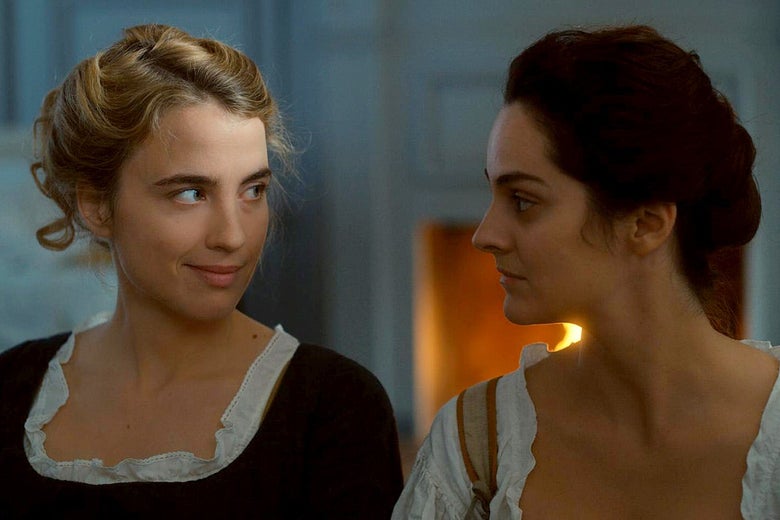
Adèle Haenel and Noémie Merlant in Portrait of a Lady on Fire.
Lilies Films/Neon
Why, Héloïse wants to know, does the portrait look so little like its subject? “There are rules. Conventions. Ideas,” explains Marianne, unconvincingly. The face in the painting, Marianne’s first attempt at a portrait of Héloïse, is placid, rosy, and conventionally feminine in its inoffensive prettiness; the real Héloïse (Adèle Haenel), though even more beautiful, has an intimidatingly direct gaze and a serious, even somber demeanor. But given the purpose of the portrait—Heloïse’s mother plans to present it as a gift to the Italian nobleman whom Héloïse is to marry, sight unseen—it’s understandable why Marianne (Noémie Merlant) would soften Héloïse’s features and blunt the severity of her expression. In Céline Sciamma’s austere yet sensuous fourth feature Portrait of a Lady on Fire (which opens Friday in New York and Los Angeles before a wide release in February), this frequently altered painting becomes an index of the changing relationship between the two young women: At first distant, proper and ladylike, it slowly turns into something passionate, truthful, and almost unbearably intimate.
Of course, another reason the portrait might not resemble Héloïse at first is because she never posed for it. Furious at her powerlessness to escape the arranged marriage, she walked out midsitting on the last artist who tried to paint her, leading him to destroy his work. Now her mother (Valeria Golino) tells Héloïse that Marianne has been brought in to be her companion on her daily cliffside walks; Marianne must soak in as much about Héloïse as she can on those walks, squirrel away sketches, and work on the portrait in private. There’s more backstory, but the information needed for the film’s stark setup is simple to grasp: two women, a canvas on an easel, a secret, the sea.
The year, according to the production notes, is 1770, but no on-screen legend or other temporal marker clues us in to that date other than the women’s corseted floor-length dresses. The location is equally indeterminate: an isolated house on a high cliff by the ocean. (The film was shot on location on the coast of Brittany.) In the early scenes especially, the story seems to take place in a timeless, almost abstract space, like the films Ingmar Bergman shot with only a handful of actors on the Swedish island of Fårö. Though men appear, namelessly and briefly, at the beginning and end, Portrait of a Lady on Fire takes place almost completely in a world made up of women: the two leads, Heloïse’s mother, the young house servant Sophie (Luàna Bajrami), and in one scene a group of village women who sing a haunting a cappella song around a bonfire. But it’s the off-screen men who call all the shots in these women’s lives; those rules, conventions, and ideas that govern Marianne’s painting of an upper-class bride-to-be are the same ones responsible for Héloïse’s desperate sense of entrapment.
To give away any more than the fact that the two women fall madly in love would be to deprive the viewer of Portrait of a Lady on Fire’s greatest pleasures: the stolen glances on cliffside walks, the conversations that end just as the truth is about to be spoken, the quiet contests of will over the content and meaning of that ever-changing canvas. Again and again Sciamma finds ways to deliver meaning cinematically rather than in words, whether through the placement of faces in the frame or a detail revealed obliquely in a mirror. In addition to being a swoon-worthy romance—a bodice-ripper in which corsets are not torn but slowly, lovingly unlaced—this is a meditation on feminism, art, and feminist art, as embodied by the portrait of the title but also by the embroidery being stitched by Sophie the housemaid—and, late in the film, by an extraordinary artistic collaboration the three young women undertake together. Without ever needing to spell it out, Sciamma makes clear that the weight of patriarchy means that this idyll by the sea may be these young women’s one chance to experience anything like real passion or freedom. That knowledge, on both the audience’s part and the lovers’, lends every moment of their time together—a fragment of music Marianne plays for Héloïse on the harpsichord, a shared reading of Ovid’s Metamorphoses—a kind of desperate poignancy.
Adèle Haenel, the fierce-eyed, dark-browed beauty who plays Héloïse, may be familiar to audiences from her roles as an uncompromising AIDS activist in the 2017 French drama BPM or a young Belgian doctor in the Dardenne brothers’ The Unknown Girl. She’s also Sciamma’s romantic partner in real life and has already played the object of desire in the director’s debut film, Water Lilies. That real-life connection, whether you go in knowing about it or not, adds another layer to what’s on screen: the story of one woman attempting to render her love for another, not only with a paintbrush but with a camera. As Marianne, Noémie Merlant is also extraordinary: As she stands at the easel her huge dark eyes take in every detail of her beloved’s face, and though she didn’t do the painting herself (the portraits in the film are by the artist Hélène Delmaire), you completely believe she could have.
Portrait of a Lady on Fire is that rare movie in which every choice feels thought through, meaningful, and right, from the costumes by Dorothée Guiraud to the cinematography by Claire Mathon. (When it comes to collaborating on feminist art, Sciamma walks the walk.) When the musical passage Marianne plays for Héloïse early in the film—the “Summer” section of Vivaldi’s Four Seasons—returns at the end in its full orchestral glory, there’s a sense of inevitable, if tragic, completeness. Just like the short time the lovers have together, Portrait of a Lady on Fire is minimal but perfect, without an image, a glance, or a brushstroke to spare.
from Slate Magazine https://ift.tt/2DPhDx3
via IFTTT
沒有留言:
張貼留言